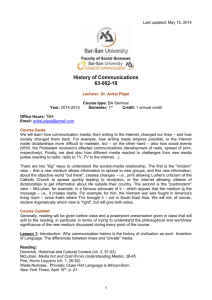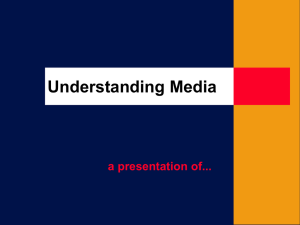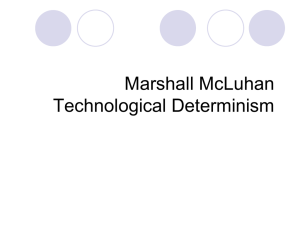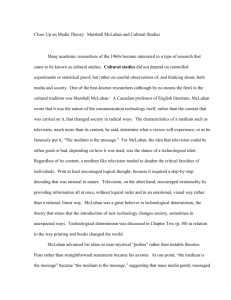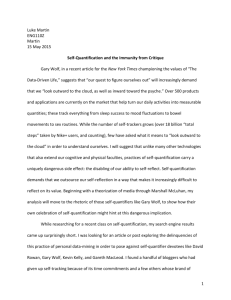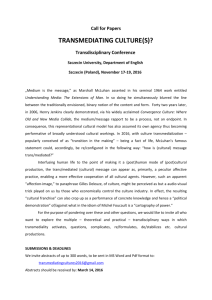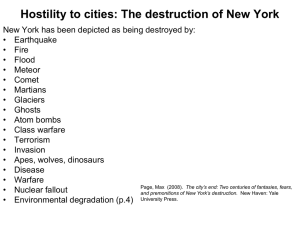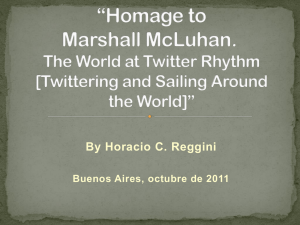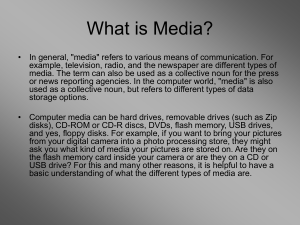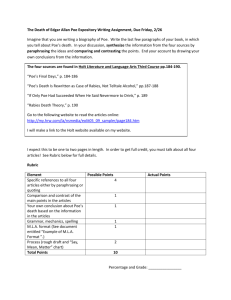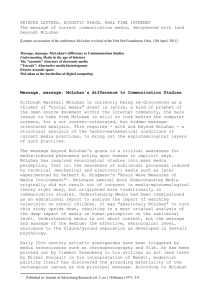History of Communications 63-002-18
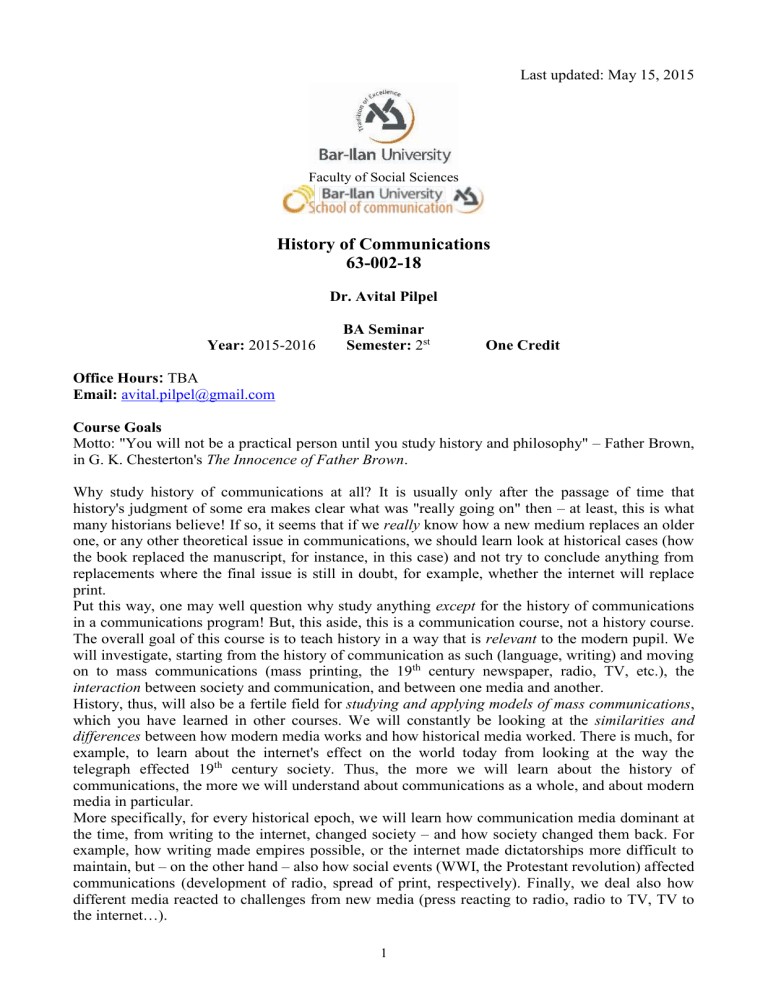
Last updated: May 15, 2015
Faculty of Social Sciences
History of Communications
63-002-18
Dr. Avital Pilpel
BA Seminar
Year: 2015-2016 Semester: 2 st
Office Hours
:
TBA
Email: avital.pilpel@gmail.com
One Credit
Course Goals
Motto: "You will not be a practical person until you study history and philosophy" – Father Brown, in G. K. Chesterton's The Innocence of Father Brown .
Why study history of communications at all? It is usually only after the passage of time that history's judgment of some era makes clear what was "really going on" then – at least, this is what many historians believe! If so, it seems that if we really know how a new medium replaces an older one, or any other theoretical issue in communications, we should learn look at historical cases (how the book replaced the manuscript, for instance, in this case) and not try to conclude anything from replacements where the final issue is still in doubt, for example, whether the internet will replace print.
Put this way, one may well question why study anything except for the history of communications in a communications program! But, this aside, this is a communication course, not a history course.
The overall goal of this course is to teach history in a way that is relevant to the modern pupil. We will investigate, starting from the history of communication as such (language, writing) and moving on to mass communications (mass printing, the 19 th
century newspaper, radio, TV, etc.), the interaction between society and communication, and between one media and another.
History, thus, will also be a fertile field for studying and applying models of mass communications , which you have learned in other courses. We will constantly be looking at the similarities and differences between how modern media works and how historical media worked. There is much, for example, to learn about the internet's effect on the world today from looking at the way the telegraph effected 19 th
century society. Thus, the more we will learn about the history of communications, the more we will understand about communications as a whole, and about modern media in particular.
More specifically, for every historical epoch, we will learn how communication media dominant at the time, from writing to the internet, changed society – and how society changed them back. For example, how writing made empires possible, or the internet made dictatorships more difficult to maintain, but – on the other hand – also how social events (WWI, the Protestant revolution) affected communications (development of radio, spread of print, respectively). Finally, we deal also how different media reacted to challenges from new media (press reacting to radio, radio to TV, TV to the internet…).
1
Course Content
Generally, reading will be given before class and a powerpoint presentation given in class that will add to the reading, in particular in terms of trying to understand the philosophical and worldview significance of the new medium discussed during every point of the course.
Lesson 1: Introduction. Why communication history is the history of civilization as such. Invention of Language. The differences between mass and "private" media.
Reading:
Dominick, Historical and Cultural Context (ch. 3, pp. 51-53)
McLuhan, Media hot and Cold (From Understanding Media )
Poe, Homo Loquens (ch. 1, 26-52)
Wade,Nicholas. Phonetic Clues Hint Language is African-Born.
New York Times , April 15 th
, p. A1.
Lessons 2-3: Mass communications in the ancient world: the invention of writing. Sumeria,
Babylon, Egypt, China; later developments – Greece and Rome. Technology of writing: from tokens and clay tablets to papyrus, paper, and ink.
Reading:
Dominick, Historical and Cultural Content (ch. 3, 53-55)
Poe, Homo Scriptor , ch. 2, pp. 66-77, 79-84
Fischer, From Notches to Tables (ch.1, 22-35); Talking Art (42-67)
McLuhan, The Gutenberg Galaxy , selections (About Oral – Tribal culture)
Lessons 4-5: Losing our minds and coming to our senses. The "dark ages" after the fall of Rome – ages without mass communications, without writing. The high and late middle ages as a return to sanity – the reemergence of writing, reemergence of national and international communication routes.
Reading:
Selections from the Talmud, old manuscripts, etc. TBA
Poe, Homo Scriptor ch. 2, 91-94.
McLuhan, The Gutrenberg Galaxy , selections (about Manuscript culture)
Lessons 6-8: Print and its effects. The invention of the printed book, the magazine, and the newspaper. Developments in print: the newspaper from the age of the broadsheet to the age of the internet site; the 19 th
century industrial revolution and its effect on print (the steam press, the paperback); new developments – ebooks, the internet as a text. Print as a source of knowledge: the academic journal, readers' communities.
Reading:
McLuhan, The Gutenberg Galaxy (about print culture, 'The Gutenberg Galaxy' proper, selections)
Poe, Homo Lector ch. 3, 115-151.
Dominick, outline and ch. 4 (invention of print / newspapers), 55-58, 81-93. http://www.cybercollege.com/frtv/mag1.htm
& following pages.
Lessons 9-10: The "Long 19 th
century" (1789-1914): Annihilating distance with the telegraph and the telephone; the photograph. The telegraph, telephone, and their precursors – tum tum drums, semaphore, bonfires on hilltops, smoke signals. What was their effect on society in war and peace? The history of photography – from the early photographs to the digital camera: the
2
invention of the negative, the film, color photography, digital photography. How the photograph and the telegraph became power—multiplying mass communication forces through the newspapers.
Reading:
Dominick, Media: Mass and Other Forms (ch. 1).
Dominick, ch. 4, 81-93 (continued)
McLuhan, Understanding Media , ch. 20, Photograph: the Brothel without Walls
McLuhan, Understanding Media , ch. 25, Telegraph http://www.floridamemory.com/photographiccollection/photo_exhibits/photographic-processes/
Lessons 11-12: Radio, television, and movies: the end of the Gurenberg Galaxy.
Radio – from Hertz, Maxwell and Marconi to satellite radio. The radio as a "global village".
Movies – silent films, talkies, color films, 3D, Imax, etc. The fight with TV. Movies – the new mythology?
TV – black and white, living color, satellite transmission, cable TV, HDTV. Effect on society –
"Amusing ourselves to death", "57 channels and nothing's on" (Bruce Springsteen). Is TV really that bad?
Reading:
Dominick, Radio (ch. 7) 149-155; Motion Pictures (ch. 9); Broadcast Television (ch. 10) 227-231.
Poe, Homo Videns (ch. 4, 153-201).
Troy, Gil. The Living Room Candidate: Presidential Campaign Commericals/ 1952-2004. Journal of American History 91(4).
McLuhan, Television: The Timid Giant ; Radio: The Tribal Drum (chs. 31/32 from Understanding
Media ).
Hoikalla et al. Wait a Minute Mr. Postman! Acta Sociologica 1987 (30), 1:87-99.
Rozack, Theodore. The Summa Popologica of Marshal McLuhan.In New Politics (sept. 1996), 22-
29.
Jackaway. The Press-Media Battle (ch. 2 of Media at War ),p/. 11-34.
Lessons 13-14: The internet. Beginnings; email; HTML invention of the web; the new internet of social networks and mobile devices. Kirkegaard about the internet – is it worldview changing effect on us the same as the one mass printing had before? How "old" media reacted to the internet.
Reading:
Kirkegaard, Soren. The Present Age. In The Present Age and of the Difference Between a Genius and an Apostle, p. 31-86.
Dominick, The Internet and the World Wide Web (ch. 12)
Poe, Homo Somnias , Ch. 5, 222-250.
Dreyfus, Hubert. Anonymity vs. Commitment: the Dangers of Education on the Internet. http://socrates.berkeley.edu/~hdreyfus/html/paper_kierkegaard.html
Course Duties:
Attendance Mandatory: 10% of grade..
Final Test:
The final test will include:
1. Mandatory readings taken from the course's textbooks.
2. An implementation of the material through written questions.
45% of grade
3
Final work:
This course is historical and philosophical. I.e., we see the similarities and differences between media of different historical periods, on the one hand, and the difference in the analysis of the postmodernist, "medium is the message" view, on the one hand, and the modernist, "information" view, on the other. 45% of grade. To be submitted on the first day of semester B .
The work shall be handed in two weeks after the end of the exam period. You need to choose two historical periods where the leading media were different, and:
1). Compare: Compare and contrast the effect of society on the media, the effect of the media on society, or the effect of one form of media on the other, between these two periods.
2). Give an argument: Discuss which of the two views we discussed in class – the "postmodernist" or the "modernist" – explains the similarities and differences between the two periods better, and why.
It is required to do research: to significantly use bibliographical material (academic articles and books, not Wikipedia or web pages) we have not studies in class to strengthen your argument. It is, of course, permissible to use the internet (including Wikipedia, online databases, Google scholar, and the like) to find the original academic sources, but one must refer and use them, not the internet pages.
The work should be, generally, about 6-10 pages including an introduction and a bibliography (that is, about 4-8 pages for the comparison and argument themselves). Length is by no means necessarily an indication of quality, but is given here as a general guide. That is, a six-page work is not necessarily at all "worse" than a 10-page one; but if your work is less than 5 pages, you are probably not going into enough detail in one of your sections, while if you're writing more than 12 pages or so, you are probably not focused, repeating yourself, or are just unclear.
I remind you of Pascal's apology to a friend: "I am sorry this letter is so long, I haven't had the time to go over it and make it shorter".
Example of possible topics:
1). Comparing and contrasting the verbal, non-literate society of the village before printing (or writing) to that of the verbal, non-literate society of radio's "global village". In what way are they similar and in what way are they different? What would McLuhan say about the similarities and differences and what would modernist critics say? Who do you think is more correct (or who gives a better explanation of some aspects of the similarities and differences and who gives better explanation of other aspects)?
2). Compare and contrasting the distance annihilating telegraph to the similarly distance annihilating internet (or, conversely, the previous distance annihilating semaphore, tum-tum drums, etc.) -- similarly, adding the "postmodernists" and "modernist" analysis and deciding who gives a better explanation of the similarities and differences.
3). Compare and contrast the ways newspapers fought with the new invention, the radio, to the way they fought with the new invention, the internet, 80 years later.
4). Compare and contrast the way newspapers effected our worldview and the way the internet did, according to the modernist view and the postmodernist view.
Bibliography
Note: as with all such courses, it is possible the reading assignment will slightly change, based on the course's evolution.
4
Books: Selections from:
Dominick, Joseph (1999). Dynamics of Mass Communication: Media in Transition. Columbus, OH:
McGraw-Hill Companies. (Textbook #1)
302.23 DOM d3 (
154171
) – 3 rd edition, 1990
Poe, Marshal T. (2011). History of Communications : Media and Society from the Evolution of
Speech to the Internet. Cambridge: Cambridge University Press. (Textbook #2)
302.209 POE h (
1208663
)
Fischer, Steven Roger (2001). A History of Writing. London, UK: Reaktion Books LTD.
N/A
Jackaway, Gwenyth L. (1995). Media at War: Radio's Challenge to the Newspapers 1924-1939 .
West Port: Prager Publishers.
N/A
McLuhan, Marshal (1962). The Gutenberg Galaxy: The making of typographic man.
Toronto,
Canada: University of Toronto Press
001.51 MAC-LUN g (385622) – in the Economics library
McLuhan, Marshal (1964/1994). Understanding Media The Extension of a Man. Cambridge, MA :
MIT Massachusetts institute of technology.
Reserved under MAC-LUH (185000)
Postman, Neil (1985/2005).
Amusing Ourselves to Death: Public Discourse in the Age of Show
Business.
London, UK: Penguin Books
302.234 POS a (282397)
Selection of other reading (academic articles, essays, newspaper articles, etc. – more TBA):
Dreyfus, Hubert. Anonymity vs. Commitment: the Dangers of Education on the Internet.
Educational Philosophy and Theory 34(3).
Hoikalla et al. Wait a Minute Mr. Postman! Some Critical Remarks on Neil Postman's Childhood
Theory. Acta Sociologica 30(1).
Kirkegaard, Soren (1962). The Present Age and of the Difference Between a Genius and an Apostle.
New-York, NY:Harper Tourchbooks Harper & Row Publishers.
Rozack, Theodore. The Summa Popologica of Marshal McLuhan. In Rosenthal (ed.): McLuhan:
Pro and Con . Baltimore: Penguin, 1969.
Troy, Gil. The Living Room Candidate: Presidential Campaign Commericals 1952-2004. Journal of
American History 91(4).
Wade,Nicholas. Phonetic Clues Hint Language is African-Born. NYT 14/4/2011
More TBA.
Some Web Pages: http://www.cybercollege.com/frtv/mag1.htm
http://www.floridamemory.com/photographiccollection/photo_exhibits/photographic-processes/
5
